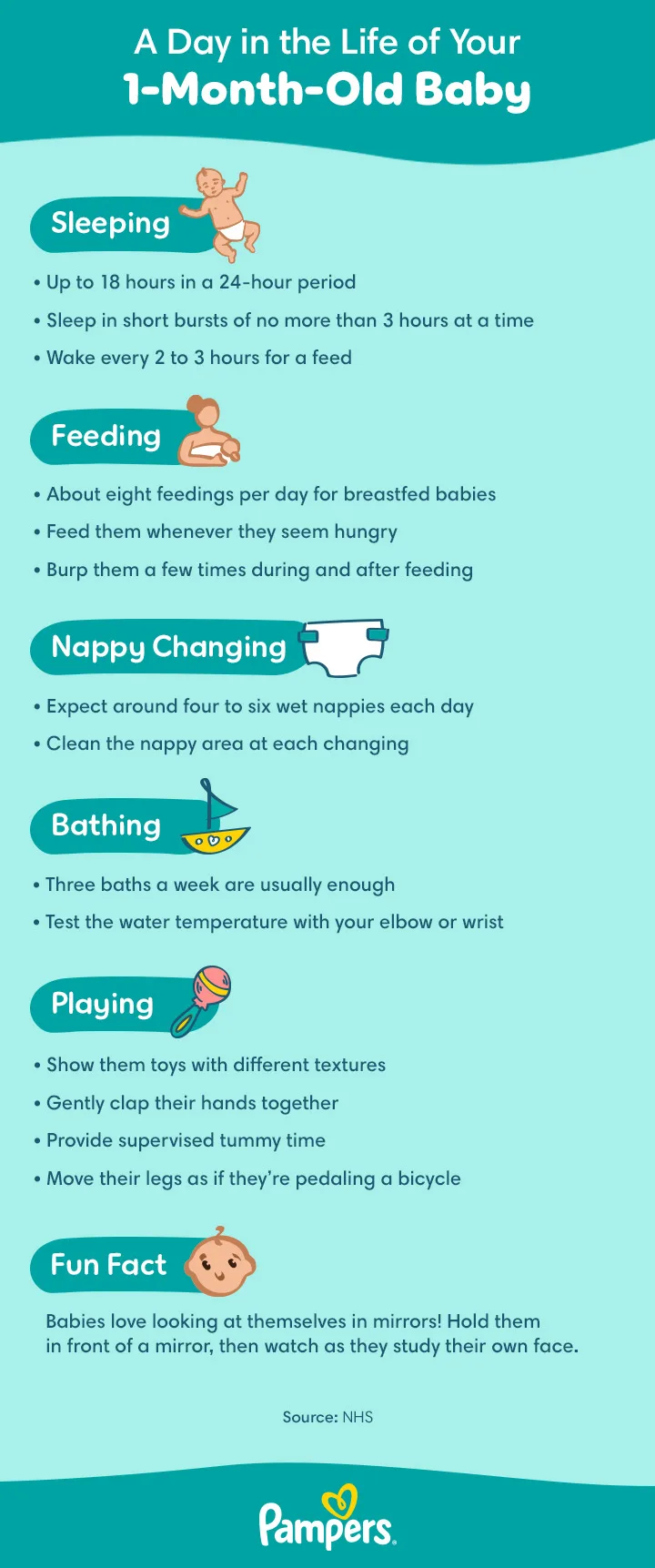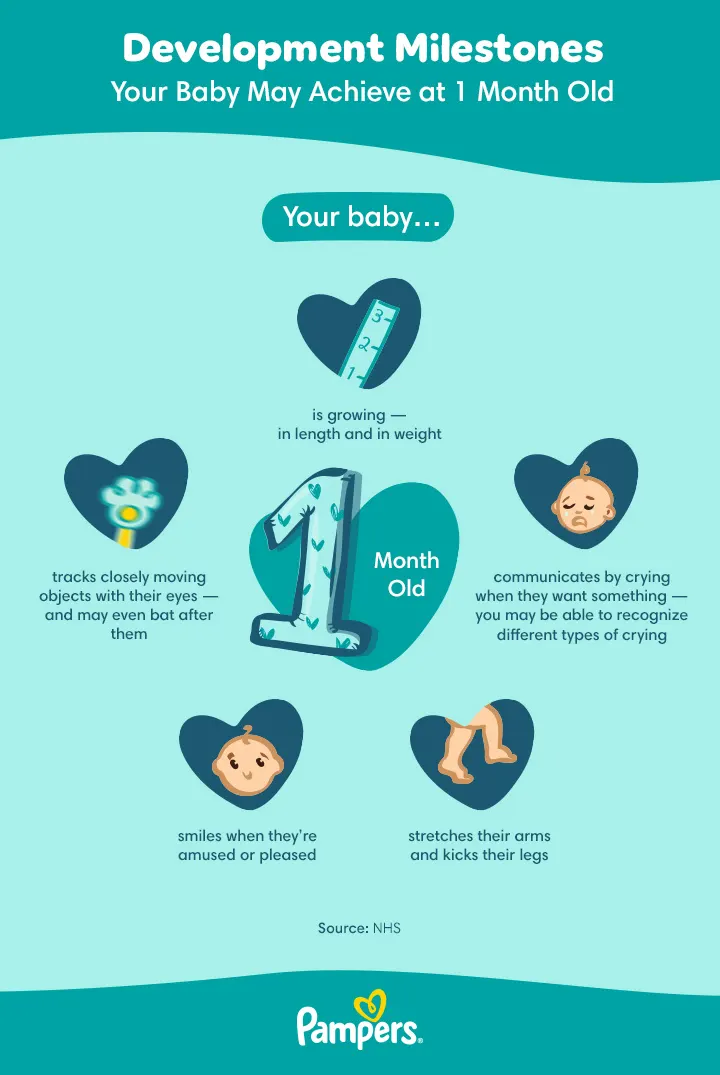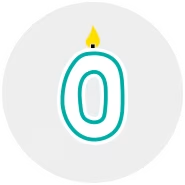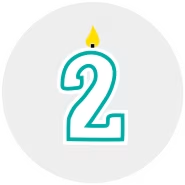1-Month-Old-Baby Development: Settling In
The first few weeks of having your new baby at home might have felt overwhelming, but as you gradually adjust to this new little person in your life, you could start to feel more confident and settled.
Don’t get too comfortable though! Newborns change and grow rapidly, so there will be plenty to learn and discover this month as well.
The good news is, we’re here to help. Read on to find out more about typical milestones your baby might reach around this time, and get info on feeding and bathing your little one.
We’ll also offer some tips on starting to form your 1-month-old newborn baby’s sleep routine and give you some info on a couple of issues that might crop up around this time, like colic and cradle cap.
Baby Development Milestones for a One-Month-Old Infant
Your baby is unique, but you know that already! It’s normal for your little one to grow at their own pace, so don’t be surprised if their development in one area seems to lag for a few weeks, only to catch up soon after. Here are some of the baby development milestones to look forward to now that your baby is one month old.
Growth and Physical Development: Another Week, Another Wardrobe
Does your little one seem to be growing out of clothes at supersonic speed? Babies tend to gain weight the most rapidly in the first six months of their lives, so don’t be surprised if those babygrows aren’t getting much use before you have to move up a size.
You may also find yourself changing up a nappy size quite often in these early months.
The growth rates of babies vary a lot, but your health visitor or paediatrician will be tracking your baby’s weight and height using baby growth charts. Your baby’s regular health and development reviews are also a great opportunity to ask questions about your baby’s growth and general physical development.
Senses: Expanding Horizons
You may be wondering how much your 1-month-old infant can see. At birth, they could probably only get a fix on things less than 10 centimetres from her face. Now, you might start noticing that you don’t have to lean in quite so close to get their attention.
Your baby is already learning to recognise faces and objects, as their field of vision expands. If you hang a mobile over their cot or changing table, you might soon see those little eyes starting to follow the colourful dangling figures.
Your 1-month-old newborn’s eyes may occasionally roll away from each other. This is normal in newborns, and usually stops happening by three months. Tell your health visitor or GP if it lasts longer than that.
Movement: Working Those Muscles
Many of the reflexes that your baby was born with are still there, like grasping your finger with their hands and toes, or making stepping movements if you hold them upright on a flat surface.
Most of these (except the sucking reflex, which is still needed for feeding) will slowly disappear over the next few months, and your baby’s reflexive kicks and jerky motions will gradually give over to more controlled movements.
All this exercise is strengthening your little one’s muscles and coordination. When lying on their tummy, your baby may already be able to lift their chin up for a few moments.
Sounds and Communication: A Smile is Worth a Thousand Words!
Sometimes it might seem that your 1-month-old infant cries a lot, but you may already be able to tell the difference between your baby’s cries of hunger, pain or even just boredom.
Remember, all that crying is not just a way of telling you that your baby wants something. It’s also helping your little one learn to control the air coming from their lungs and use those vocal chords – an important step on the way to speech!
As well as crying, your baby may soon start to make cooing sounds, which will get more and more varied and expressive as time goes by.
This month, if you haven’t experienced it yet, you might be treated to your baby’s first true smile. They’ll flash that toothless little grin when they’re awake, in response to something like the sound of your voice — and your heart will melt.
Activities for Supporting Your 1-Month-Old Baby’s Development
All that wriggling and kicking your baby’s doing is great exercise. Help your little one get an all-over workout by changing their position frequently and giving them the chance for plenty of ‘tummy time’.
Here are some other activities you could try this month to help support your 1-month-old baby’s development:
Tummy time. Tummy time helps your baby’s development, building strength and improving coordination in preparation for later milestones such as rolling over, sitting and crawling. Don’t forget that even now your baby might roll over unexpectedly, so never leave them unattended, even for a moment on a changing table, bed, sofa or other raised surface.
Sensory stimulation. Try giving your baby toys that stimulate lots of different senses. Musical mobiles, rattles and other tactile toys with different textures, materials and bright colours are all great for keeping your little explorer entertained and curious.
Talking to your baby. Describing the things around you, reciting nursery rhymes and reading books are great ways to bond and help develop your little one’s communication skills. Your baby might even join in with smiles and gurgling or cooing noises as they get better at responding to the world.
Singing. Your baby loves to hear your voice, even if you aren’t the greatest singer in the world! Songs or nursery rhymes are great for soothing or entertaining your baby.
Dancing. Try putting on some music and dancing with your baby in your arms. The gentle rocking motion and closeness are fantastic for bonding and your baby’s emotional development.
Playing peek-a-boo. If you’re wondering how to entertain or play with your 1-month-old infant, a game of peek-a-boo always works! That’s because babies love seeing faces, especially those of their parents.
Bonding through touch. The first year of your baby’s social and emotional development is all about building feelings of safety, security and trust. Touch is an important way of bonding and helping your baby’s social and emotional development. Ask your midwife about baby massage lessons in your area, and consider using a baby sling. This allows you to hold your baby close while freeing your hands for other daily tasks.
Feeding Your 1-Month-Old Baby
You may wonder how much a 1-month-old baby should eat as they grow. Feeding routines can vary a lot between babies, so there’s no one-size-fits-all feeding schedule for a 1-month-old.
Continue to feed your baby whenever they seem hungry. This could be 8 times or more in 24 hours. During growth spurts, your baby may want to eat a little more.
If you’re breastfeeding, it can be difficult to know precisely how many millilitres or ounces of milk your little one is actually getting. But, however you choose to feed your 1-month-old baby, your little one is probably getting enough nourishment as long as they:
continue to gain weight steadily
seem healthy and alert when they’re awake
do at least 2 soft, yellow poos a day on average, and produce at least 6 wet nappies every 24 hours.
If you’re breastfeeding, it’s worth taking a look at our FAQs on breastfeeding and if you have any more questions, speak to your GP or lactation consultant.
Burping Your Baby
If your baby gulps down a bit of air while feeding, it can get trapped in your little one’s tummy, making them feel uncomfortable and cry.
This can happen regardless of how you feed your baby, although it’s a bit less common if you’re breastfeeding your little one.
Burping (winding) your baby during feeds helps relieve the discomfort. There are no hard and fast rules on when and how you should burp your baby. It might be enough to wait until after the feed, but if your little one looks uncomfortable mid-feed, you could pause for one or more burping breaks.
Sometimes a little breast milk or formula may come back up along with the air, so have a muslin square or small blanket covering your clothes before trying out these burping positions to see which one works best for you and your baby:
Wet and Dirty Nappies
It’s common to wonder how many wet nappies a 1-month-old will go through. At this stage, your baby will be producing around six wet nappies a day. When it comes to dirty nappies, it’s perfectly normal for your little one’s poo to change from week to week, or even day to day.
Most babies will have at least a couple of bowel movements a day, but some may go a few days or even a week without filling a nappy. So your baby not pooing for three days is probably OK, as long as the consistency of the stool is soft and your child is eating well and gaining weight over time.
Tell your health visitor or GP if you’re concerned that your baby’s poo has suddenly become very smelly, runny or hard, or if it contains any blood.
To protect your baby’s delicate skin amid all these nappy changes, it’s worth using a soft, comfortable nappy.
How Much Sleep Does a 1-Month-Old Baby Need?
At this stage, your baby might spend between 8 and 18 hours asleep out of every 24 hours, although not all at once!
It’s important to let your baby sleep whenever they’re feeling drowsy.
Your 1-month-old’s sleep schedule probably has little to do with whether it’s dark or light outside. Over the weeks ahead, you can slowly start to help your little one learn the difference between day and night. Here’s how:
In the daytime, spend time talking and playing with your baby, and don’t worry about making noise during those naps.
At night, keep the lights dim during nappy changes, and avoid playing with your baby or talking too much.
Wake your baby for a feed just before you go to bed. This way they might sleep a little longer at night, letting you get some much-needed shuteye.
Remember, whether it’s for a short nap or the longer night-time stretch of sleep, always follow the safe sleeping guidelines to reduce the risk of SIDS when you put your baby down to sleep.
With all your baby’s midnight feasts, it’s no surprise if you’re starting to look a little frazzled! This won’t last forever, and it’s normal to find it difficult to cope. It’s important to ask for help if you need it.
If you have a partner, they could do some of the feeds with expressed milk or formula. Or maybe a friend or relative could stay for a few days to help out. You can also speak to your GP or health visitor if you’re feeling down.
A Day in the Life of Your 1-Month-Old Baby
Here is an example of a routine for a 1-month-old baby, including bathing, sleeping, feeding and playing:
Your Baby’s Health
Some health issues to be aware of around this time include:
Cradle cap. This is a common, harmless skin condition that causes crusty, flaky patches of skin, usually on your little one’s head, although it can appear on other parts of the body too. It’s not infectious and usually clears up by itself with time.
Diarrhoea. Frequent, watery and unusually smelly poo could be the first sign of a stomach bug. Babies under one year have a higher risk of dehydration with a runny tummy, so always seek medical advice if your 1-month-old infant has diarrhoea.
Constipation. It could be constipation if your baby’s poo is hard and pebble-like, large and difficult to push out, or if your little one doesn’t poo at least three times a week. Remedies like prune juice, malt extract or rice cereal do not relieve constipation in babies. Giving your 1-month old baby small amounts (30-40 ml) of boiled and cooled water to drink may help get things moving again.
Vomiting. See a doctor if your baby vomits forcefully (as opposed to just burping up a little breastmilk or formula after a feed), especially if it lasts for more than a day or two, or if your baby also has a temperature or diarrhoea.
Reflux. It’s normal if your baby burps up a little milk during or shortly after feeding or being winded, but do seek medical attention if your baby seems irritable during feeds; has feeding difficulties such as refusing feeds, coughing, gagging or choking; or shows any other signs of being unwell.
Baby acne. Around this age, pimples may appear on your little one’s face. They usually clear up in a few weeks or months, but you can help by gently washing your baby’s face with water and a mild moisturiser.
Early Hygiene Habits
Bath time is not only important for hygiene but can also be a great bonding experience. There are no hard and fast rules about how often to bathe your 1-month-old baby. Two or three times a week is typically enough, but if your little one really enjoys it, feel free to let them have a good splash about every day.
You may already have got the hang of bath times, but if you want a little more guidance, read more about how to bathe your baby.
When Is Crying Colic?
All babies cry from time to time, but crying may be a condition called colic if it lasts for more than three hours a day, three days a week, for at least one week.
It could be a sign of colic if your baby
is hard to soothe or settle
clenches their fists
goes red in the face
pulls their knees up to the tummy or arches their back
has a rumbling tummy or severe wind.
Its causes are not fully understood, but colic can develop when your baby is a few weeks old and usually clears up when your little one is about six months old.
If you think your baby might have colic, ask your health visitor or GP for advice. As always, it’s vital to seek medical attention immediately if your baby’s crying is weak or high-pitched, or doesn’t sound like their normal cry.
Living with a baby who has colic can be stressful, especially when nothing seems to calm them down. If you feel at the end of your tether, never shake your baby. Just put your little one down in the cot, making sure they’re safe, and take a short break in another room.
You might also be able to ask a trusted friend or loved one to care for your baby for a few hours, to give you some much-deserved ‘me time’.
Remember, colic doesn’t last forever! The problem should clear up by itself in a few weeks or months. Meanwhile, it’s important to look after yourself as well, so don’t feel shy about asking for help from family and friends.
Your health visitor or GP can direct you to local or national support groups, and if you need to talk to someone straight away you can call NHS 111 at any time for advice.
Regular Health Reviews and Vaccinations
Your baby’s next health and development review is probably coming up in the next two to four weeks when your little one will be given a thorough physical examination.
Your health visitor will take all the main measurements (your baby’s weight, length and head circumference) and also check your little one’s heart, hips and (for boys) testicles. Your health visitor will talk to you about any vaccinations coming up, and you’ll have a chance to ask any questions you have about your baby’s health and development.
Your health is important too, so this is also a great opportunity to talk about your own well-being.
Development Tips for Your Baby This Month
Here are some tips to help you bond with your little one and help them feel safe and secure, key components of healthy development:
Provide close, warm, and consistent physical contact. Holding and hugging your baby as often as possible promotes your baby’s sense of security and well-being. Continued skin-to-skin contact is also important. Ensure others in the household, as well as all caregivers also provide the same loving care to your baby. There’s no way you can spoil your baby by giving them the attention they need.
Talk to your baby. Say your baby's name and use simple phrases to narrate some of your actions, such as during dressing, nappy-changing, bath time, and feeding. Respond to their facial expressions and gestures – it’s a conversation! If you or your partner speak a different language, feel free to use it with your baby.
Read to your baby. Daily reading helps foster your baby's language development. Reading together also creates a feeling of physical closeness.
Be attuned to your baby’s personality and rhythm. Even at this early stage of their life, you know a lot about your baby: their temperament and moods, their likes and dislikes. Paying attention to their cues will help you respond to their needs.
Items You Will Need This Month
Whether you’ve already bought some of the following baby products or have received them as gifts, these are things you may be reaching for this month:
Nappy bag. You may start heading outside more often this month and a nappy bag will help keep all your baby’s things organised, including nappies, wipes and an extra change of clothes, among other necessities.
Baby bathtub. By now your baby’s umbilical cord stump has fallen off, so it’s time to bring out the baby bathtub.
Baby wash/shampoo and other bath-time supplies. A multi-purpose baby wash or shampoo designed for sensitive skin is a good choice.
Nappies, wipes and nappy rash cream. You’ll continue to go through a lot of nappies in the months ahead, so it’s smart to stock up on supplies in advance.
Sound machine. If your baby takes a while to fall asleep, you may consider using white noise or very soft music to help lull them to sleep.
Humidifier. If the air is dry in your home, or if your little one comes down with a cold, your baby's health visitor or doctor may suggest using a cool-mist humidifier in the room your baby sleeps.
Night-light. Having a night light is helpful when it comes to those late-night feeds and check-ins. With a night light there’s no need to disturb your baby by turning on a bright overhead light.
Baby thermometer. Babies tend to run fevers, and you'll need a thermometer specifically designed for babies, along with an up-to-date first-aid kit.
Your Life as a Parent: A Problem Shared Is a Problem Halved
You might be feeling more confident this month as some of the uncertainty you may have felt during the first few weeks starts to fade away. Even so, it can still be reassuring to talk about any concerns you have with friends or loved ones. Your health visitor and GP are also there to help answer your questions.
There are plenty of local or national support groups for single parents or families dealing with specific issues. Your health visitor or GP will be able to point you in the right direction.
Remember, a problem shared is a problem halved, and you might be surprised how much better you feel afterwards.
If you're breastfeeding, you might experience discomfort resulting from a breast infection called mastitis. Get in touch with your health visitor or GP if you notice flu-like symptoms followed by soreness in a breast, as it’s important to start treatment straight away.
If you do have mastitis, it’s best to keep on breastfeeding, as the milk is not affected, and it may actually help clear up the problem faster.
FAQS AT A GLANCE
At 1 month old, your baby may be primarily sleeping and eating. They might start showing early social behaviours such as responding to faces and possibly smiling, but most activities involve basic interactions like feeding, sleeping and sensory development.
Checklist for This Month
If you haven’t already been, schedule and take your baby to his or her next health and development review.
Sign up for a baby first aid course and encourage others who care for your baby to attend along with you. If you’re unsure where to find such a course near you, ask your health visitor.
If you’re eager to know what’s ahead next month, take a look at what you might experience once your baby is two months old.
If you haven’t already, download Pampers Club App to earn free nappies.
1 month old baby - checklist
How We Wrote This Article The information in this article is based on expert advice found in trusted medical and government sources, such as the National Health Service (NHS). You can find a full list of sources used for this article below. The content on this page should not replace professional medical advice. Always consult medical professionals for full diagnosis and treatment.






